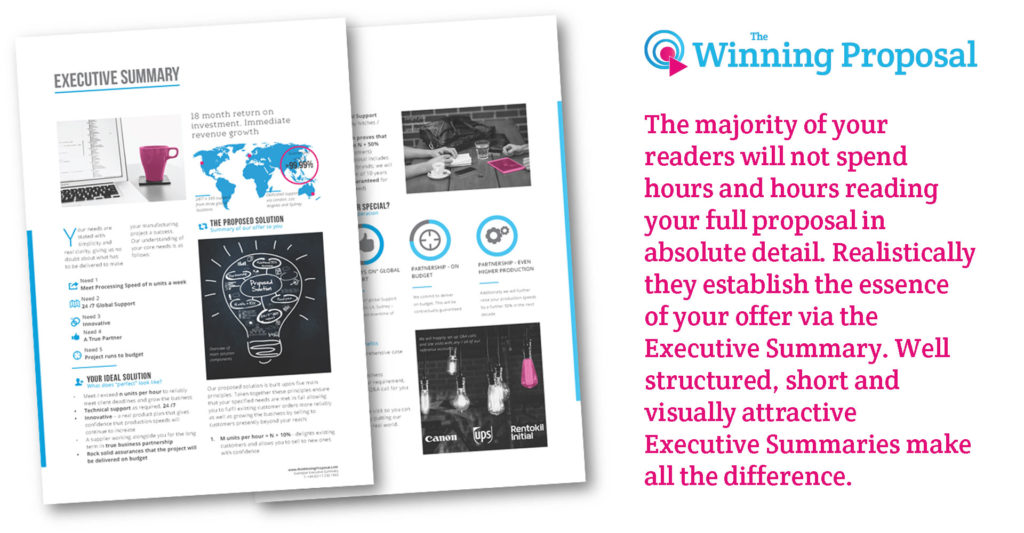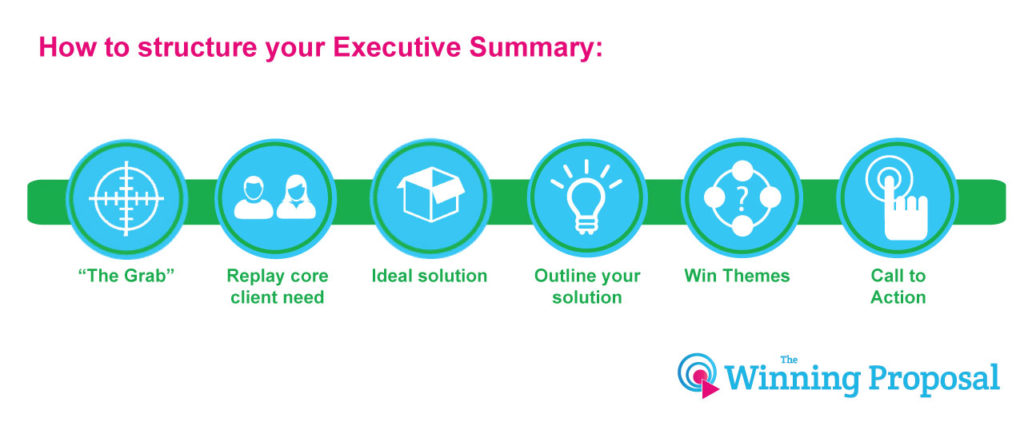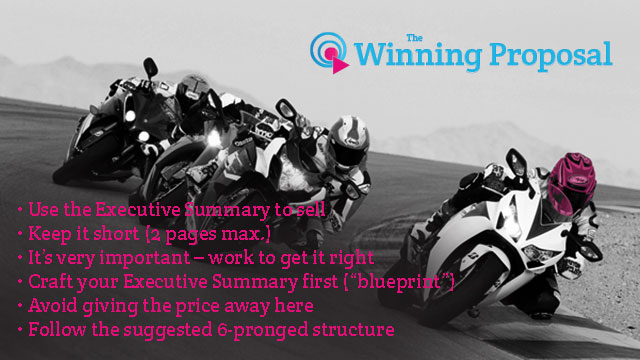Many sales people simply do not understand what an Executive Summary is supposed to be. So, they lose out on tenders and proposals they should really be winning.
Is their misunderstanding of “Executive Summary” based on the correct principle that client-centric selling is really important, but a false presumption that this means somehow pandering to customers all of the time?
If so this explains why the proposal authors / salespeople might have a concept of a senior decision maker (“an executive”) looking to get a quick overview (a “summary”) of the full proposal, hence the need to deliver a quick summary of all that’s to follow in the main body of the proposal.
An Executive Summary should not simply summarise the main proposal.
You cannot possibly summarise tens or hundreds of pages into just one or two pages (if you could you would have done so and saved yourself a hell of a lot of time and effort!).
If we shouldn’t be attempting summarise the full proposal, what should we being doing with the Executive Summary?
The importance of the Executive Summary
Your Executive Summary is by far the most important element of your entire proposal.
It’s the bit that your readers – your buyers! – get to first when they are still nice and fresh and, hopefully, are feeling optimistic about embarking on their exciting journey through your sales proposal.
This is your biggest and best opportunity to sell to your buyer in your proposal, so use that opportunity wisely.
Now, there’s something of a devil’s pact at play here.
The majority of your readers know that they are unlikely to spend hours and hours reading your full proposal in absolute detail. And you know that too. Realistically they are going to try to establish the essence of your offer via the Executive Summary.
At the same time, you know – or you should know – that the couple of pages at the front of your document don’t faithfully summarise all the main points of what’s about to follow.
The pact is this: that you offer the reader a nice easy shortcut and you get your chance to sell.
But how? The pact only works if your Executive Summary is no more than two pages (ideally just one page) and if you follow a simple time-tested structure that works for buyer and seller (below).
A tried and tested Executive Summary structure
The winning Executive Summary has only six component elements and looks like this:
1. “The Grab”
In just one or two sentences summarise the main benefit/s of your solution – and yours alone – using strong and emotive words and phrases such as “evidential, sustainable gains”, “decade-long cost-savings”, “demonstrable return on investment”, “consistent, impactful market traction”.
Really grab the reader’s attention in those first few seconds.
2. Replay Client Need
 It is important that you can demonstrate a sound understanding of the client’s primary needs, so replay those – again in just one or two succinct sentences – to prove beyond doubt that you have fully understood what is required of you, and therefore of your proposal.
It is important that you can demonstrate a sound understanding of the client’s primary needs, so replay those – again in just one or two succinct sentences – to prove beyond doubt that you have fully understood what is required of you, and therefore of your proposal.
Some of your reviewers may not be fully aware of the requirements of the client project and will also have zero motivation to read all the background project documentation.
A very short statement to replay client need acts as a helpful backgrounder for such individuals.
Your replaying of client need should be more than simply regurgitating what the client has previously stated in their (no doubt rather wordy) project documentation.
Get to the heart of their issue/s whilst simultaneously bringing to light your own perspective, showing that you fully comprehend the prospect’s requirement.
For example, consider these formulations:
- “Within three years you want to drive a minimum 5% increase in manufacturing output”
- “You need to demonstrate strict adherence to the government’s new KPI regime within the stated financial envelope”
- “Your call centre cost base spend has to be reduced by $250,000 per annum without any discernible decline in customer service standards”
3. Ideal Solution
![]() Having shown an understanding of the business requirement, we move now to evidence our understanding of the solution that is required. But this is not an overview of our solution (that comes next, section 4).
Having shown an understanding of the business requirement, we move now to evidence our understanding of the solution that is required. But this is not an overview of our solution (that comes next, section 4).
The ideal solution is the one that successfully addresses the acknowledged needs and problems with measurable and positive impacts that definitely meet the stated needs.
Sometimes this is construed by bid developers as “stating the [beeping] obvious”, but the approach works to cement your credibility as an organisation that takes the trouble to understand customers’ needs and to listen carefully; and, secondly, is solution-oriented – intent on taking client pain away.
Prospects and customers value problem-solvers – people who make their working lives easier and better. Make it perfectly clear, as early as possible, that this is exactly the type helpful organisation you represent.
Examples might include:
- “Within 36 months of project go-live your factory output will be 5 – 7.25% high than is currently feasible”
- “You will meet all of the new KPIs whilst rigorously adhering to the prescribed budget”
- “The operating costs of your call centre will be reduced by $250k per year whilst the very high standards that your customers have come to expect from a brand as strong as yours will be maintained and further enhanced”
4. Outline your Solution
Summarise your solution, stating briefly how your offer meets the acknowledged problems and drives the outcomes of the ideal solution.
Now, it may be tempting to cut and paste some of what you perceive to be the best wording from the main document here, but avoid that.
Much better to deploy a telling, highly-impactful visual summary of your solution with minimum text (e.g. simple labels).
Remember: “a picture tells a thousand words”. A strong, bold graphic has the effect of triggering your audience to want to know more about your solution, especially after such a strong introduction to the proposal.
Your reader will still be on page 1. If your solution is introduced on page 2 you’ve been too wordy – get your red pen out!
5. Win Themes
 What makes you special? What do you know with 100% certainty that differentiates your bid from any others that your prospect might have also received?
What makes you special? What do you know with 100% certainty that differentiates your bid from any others that your prospect might have also received?
Identify between three and five things that make your bid truly unique that you know will be highly valued by your prospect – these are the elements of your offer that make you stand out – your win themes.
If you find yourself guessing what the prospect values stop right here on page 2 and make the brave – but sensible – decision to “No Bid” because your chances of winning are just too small.
What differentiates your bid in the eyes of your prospect will, however, vary from one proposal opportunity to the next, but might include:
- “Trusted to implement on time and on budget”
- “Solid real-world reference accounts you can talk to”
- “Independently verified by leading experts as having the highest rates of adherence to KPIs in the industry”
- “We have undertaken several projects where we have already delivered outstanding results where client needs were very closely aligned with your own”, and so on
6. Call to Action
Any proposal is a call to action – initiated by your prospect!
Since your Executive Summary is partly a blueprint for the full proposal and your entire approach to the project, what action or actions might you be prepared – and even want to take – to move this sale forward?
Something like “we are really excited to have this opportunity to work in close partnership with you” is week and potentially cheesy, but better than nothing as it reminds everyone that there is work to be done together.
A stronger call to action could take on a format like this:
“We understand that your needs are unique, but many of your needs and wider business circumstances are broadly in line with those faced two years ago by our client the ABC Company. ABC were able to hit a business-transforming 6.75% improvement in manufacturing throughput. ABC’s Head of Operations has already told us that she would be delighted to host you at their main production facility for a day next month to see the solution in action”.
This makes everything very “real” for everyone involved in this proposal, giving confidence that you can deliver.
A call to action in the form of a reference site visit gives your prospect a proper chance to assess the solution in a low risk yet extremely informative manner.
With a well-crafted call to action you nudge your proposal closer to an order.
Should we give them the price here?
Is price your main or only differentiator? If it is then you should indeed give your price within the Executive Summary.
However, even though price is an important assessment criterion for buyers it is most usually only one of a basket of elements that together deliver true value for money.
Leading on price means that you may well lose the deal. In any case …
… any costing figures always look too high when introduced before you have completely explained what your solution is all about (and this, of course, is the point of the full proposal).
First or Last?
Should you write your executive summary before you’ve written the main proposal or afterwards?
You’ve now had the benefit of reading this article so you may have already come to an informed opinion on this question.
We often ask this question early in our workshops and over 75% of the time the answer is “we should write the executive summary last because until you’ve written the whole proposal document you can’t possibly summarise it.”
Wrong answer!
 The Executive Summary is your compelling sales argument – the reasons why the prospect should go with your solution and your company ahead of anyone else.
The Executive Summary is your compelling sales argument – the reasons why the prospect should go with your solution and your company ahead of anyone else.
By composing your Executive Summary right up front and at the start of the proposal development process you create the blueprint upon which to build the main body of the proposal.
Then, using the blueprint as a reference tool for you and your development team, you and colleagues can go back to it anytime you need to. A solid Executive Summary operates as a great refresher.
The end result is a tight, lean, persuasive proposal – the winning proposal!
So, it makes sense to invest a reasonable amount of time getting the Executive Summary right – crisp and compelling – and sharing it with colleagues, getting their comments and ultimately their buy in. Getting the buy in and support of your co-workers hugely increases your chances of getting the buy-in of your prospect.
Summary
Could we help?
The Winning Proposal works with Sales and Marketing departments to develop more impactful and successful tenders and sales proposals. We manage processes, coach bid managers and train those involved in proposal development.
If you would like to explore any if the ideas raised in this article please drop us a line.





